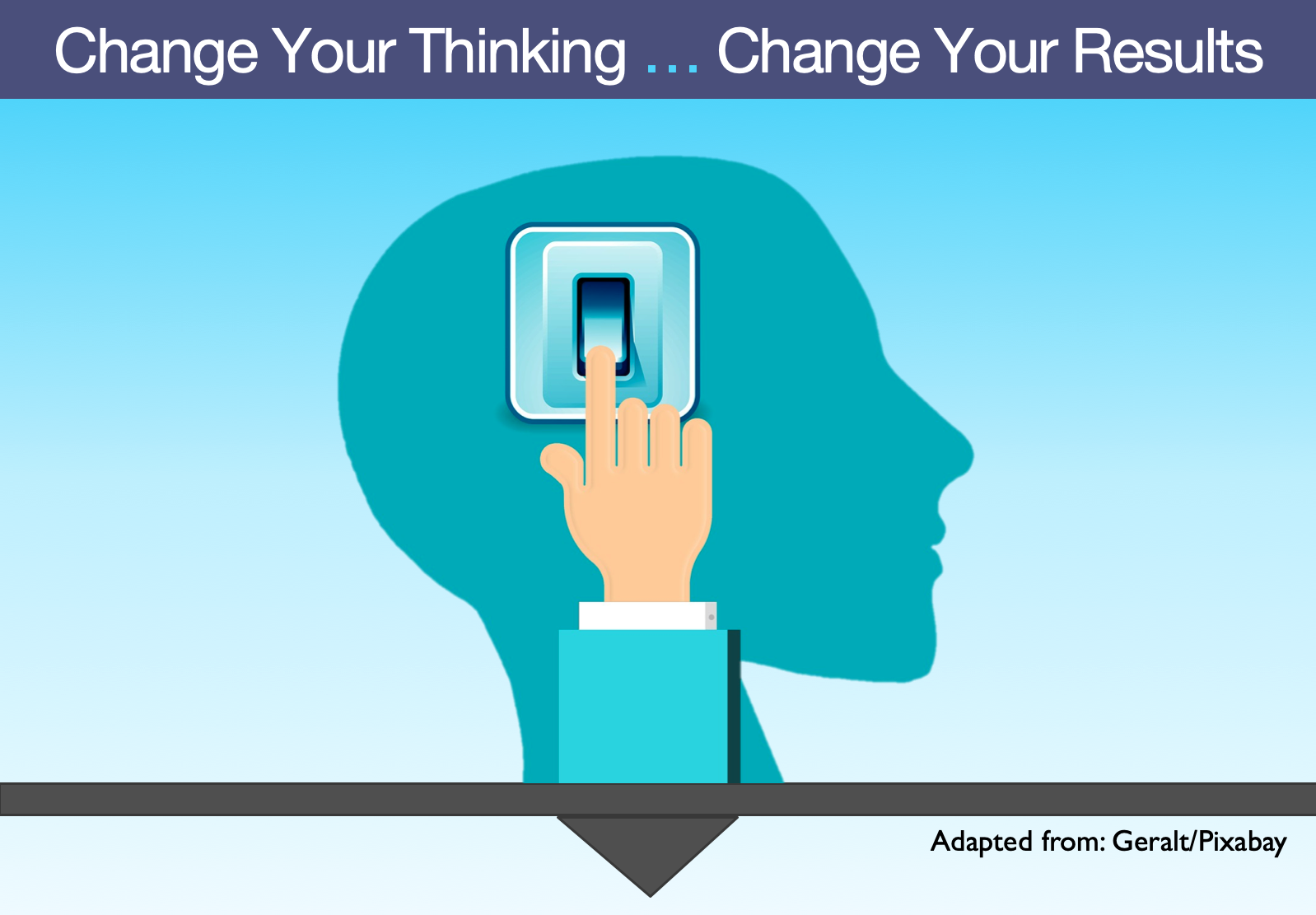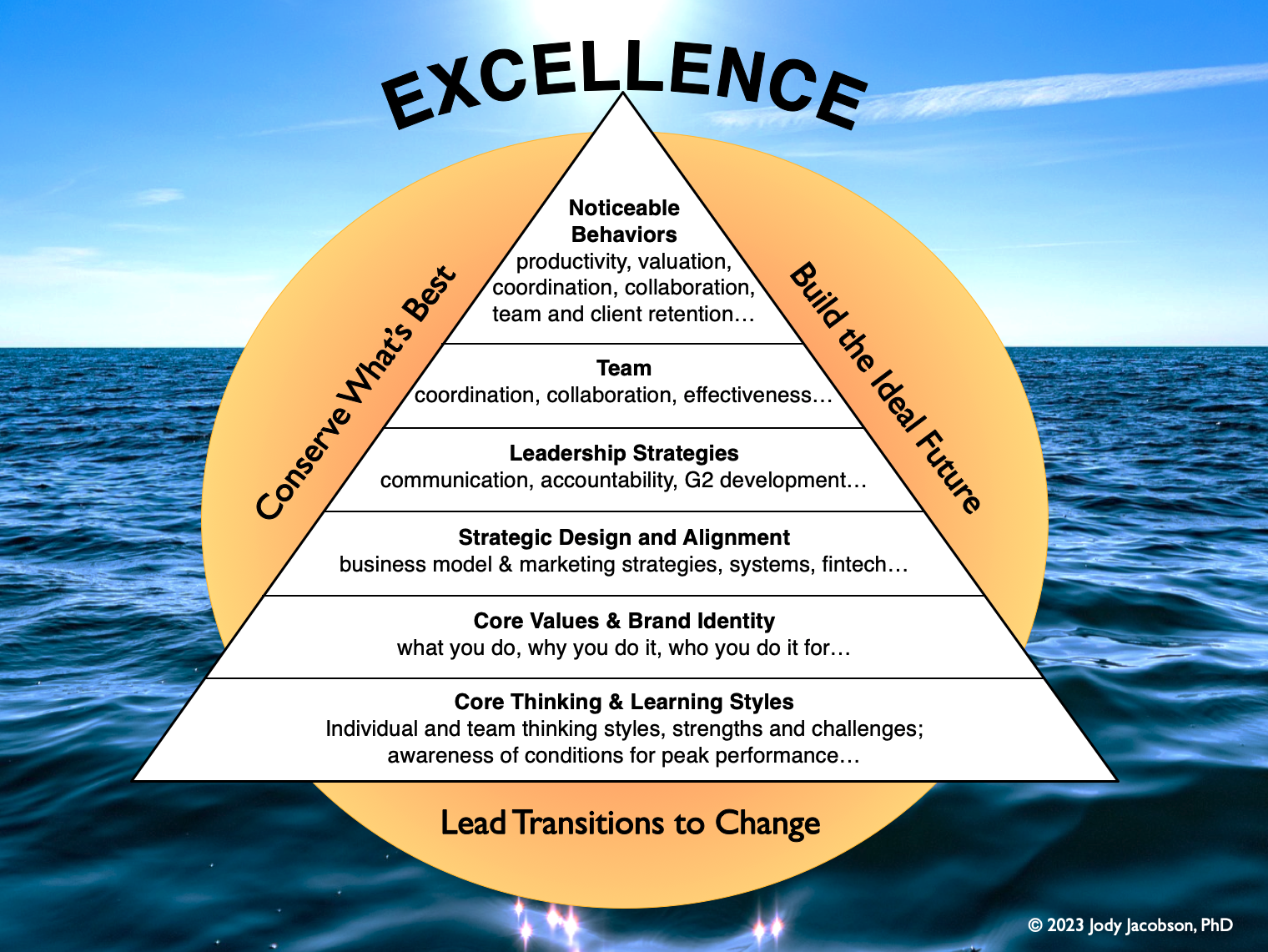COACH'S CORNER
| Print this Article |
Beyond Personality Assessments: Why Identifying Thinking and Learning Styles Is Key for Long-Term Growth
By Jody Jacobson
Have you ever had a heated argument with a co-worker, friend, or partner, only to have an “aha!” moment when you realized you were both saying the same thing? It’s not that you weren’t listening to each other. You just were not understanding the other’s thinking until that magic moment when your ways of thinking crossed paths, and you realized you were on the same page all along. It’s as though one of you started reading the book from chapter one, and the other started at the end and worked back to the beginning. This often happens when one person has a more concrete, step-by-step thinking style, and the other is a big-picture thinker who needs to see the whole before grasping the parts.
 Being aware of how you and your team members and clients think best and most instinctively is a first step in making choices that can optimize your results and maximize opportunities for growth and long-term success.
Being aware of how you and your team members and clients think best and most instinctively is a first step in making choices that can optimize your results and maximize opportunities for growth and long-term success.
In over 20 years of working with advisors—from founder-owners of highly profitable complex advisories to small and solo-led firms to next-generation advisors—it’s been my experience that most problems originate at the level of thinking. Personality differences then exacerbate the problems and fuel conflicts. Therefore, I recommend starting a new engagement with thinking, learning, and personality style assessments. Doing so allows you to a) present new information and recommendations in language familiar to your clients and tap into concepts and tools they already know, and b) provide meaningful insights and knowledge for facing future challenges.
Working together, you can use this information to resolve existing problems and implement strategies for performance excellence and sustainable growth.
Awareness of Thinking Styles as Foundation for Sustainable Growth
The diagram below illustrates the role that thinking styles play in anchoring and aligning your firm’s strategies, leadership style, services, and, ultimately, your use of your core strengths. Thinking styles are located at the bottom of the pyramid of organizational design, whereas personality styles tend to be more noticeable.

Thinking beyond Personality Assessments
Working with advisors, I have found thinking-style inventories to provide the most actionable data. Some of these include the InQ first presented in Allen F. Harrison and Robert M. Bramson’s The Art of Thinking, Peter Merrill’s Innovation Types Assessment (available on his website), and other proprietary inventories developed by learning theorists. When combined with evidence-based personality assessments, such as Kolbe and the Myers-Briggs Type Indicator (MBTI), these provide a unique doorway into understanding:
- How your and other team members’ minds work
- How that affects work outcomes, from hiring the right person for the job to team development, implementing your succession plan, and more
I am a personality inventory junkie. I value and use many of them—Kolbe, Clifton Strengths, VIA Strengths, and MBTI. There is a downside, however, as their usefulness and application often stop with personal awareness and enrichment. Applying findings to teams and clients can be complicated. On the other hand, while assessing thinking styles can head off many unintended problems, awareness of these styles alone is not a magic bullet. Other factors can limit growth and frustrate goal achievement—e.g., lack of skill or initiative or a partner who changes strategic direction.
The following two examples illustrate how better understanding thinking styles can help you prevent or resolve many common problems on the people side of your business:
1. The Overloaded Position Description
A common mistake is overloading position descriptions (PDs) with roles, responsibilities, and tasks to the extent that the job requires two opposite thinking styles (two brains, one body). Frequently, this occurs with PDs for office manager and paraplanner, jobs typically requiring linear, detailed-oriented thinking with which the person is happy ensuring every “i” is dotted and every “t” is crossed. On the other hand, a position for designing new systems, or restructuring existing ones, often requires a more holistic, relational style of thinking. The designer-systemizer personality loves the challenge of figuring out a system.
The person you need to manage detailed tasks, such as scheduling and onboarding, typically is not happy to discover they’ve joined a disorganized firm. For them, coming to work and making the trains run on time is exciting and fulfilling. They have no desire to design the trains first, whereas the system designer is adept at assessing needs (human and technical) and constraints and designing solutions around those. Once they’ve figured out the system, they have little desire to stay on to manage it.
Potential Solutions from a Thinking Styles Perspective
1. Design PDs for your future hire’s success.
2. Streamline the position description rather than overstuff it.
3. Have your top finalist(s) take one or two simple thinking-style inventories to assess the quality of their fit to the roles and responsibilities of the role.
4. Determine if the overflow tasks can be outsourced, distributed, or done by a part-time hire.
2. Motivating Clients with ADHD and/or Dyslexia
If you work with high- or ultra-high-net-worth business owners and entrepreneurs, you may have noticed their perplexing lack of follow-through. While this may be attributed to busy schedules, studies suggest that 29% to 35% of business owners and entrepreneurs have attention-deficit/hyperactivity disorder (ADHD) and/or dyslexia. These people are often big-picture, visual thinkers.
Potential Solutions from a Thinking Styles Perspective
1. Start with a big-picture overview for meetings, decisions, and actions.
2. To aid learning and memory, include visuals in your client meetings.
3. Assign no more than three to five client follow-up tasks.
4. Send a meeting summary with action items and suggested completion dates.
Taking action will help not only you but also all other internal and external stakeholders.
You risk prolonging the suffering and increasing opportunity costs when you resist dealing with these situations—e.g., by procrastinating, hoping things will improve, or worrying about what others will think of you. Rise above your fears. Taking action will help not only you but also all other internal and external stakeholders.
Changing How You Think Is Not a No-Brainer!
Changes, good or bad, typically involve some pain. A familiar way is ending, and you will enter a psychological zone of transition that may be fraught with uncertainty. The human brain’s protective fight or flight instinct is designed as a gatekeeper guarding against entry into the uncertainty of transitions.
Avoidance of transitions is hard-wired into the human brain. The Harvard Business Review estimates as much as 70% to 80% of change efforts either fail completely or fail to fully meet their objectives because they do not address the psychological (human/people) side of change. Transitions happen at the intersection of people—how and what they think and their beliefs and values—and organizational and technical systems.
Working with advisors, I have witnessed, time and time again, the positive effects a conscious focus on thinking can have. This can, for example, help RIA owners manage the psychological and organizational sides of change and growth efforts, build higher-functioning teams, write website text that attracts the right clients, and help next-generation women advisors transform their internal narratives from the stance of dutiful young intern to dynamic rising leader.
When working with partners, next-generation leaders, other team members, referral partners, and clients, knowing your and their ways of thinking helps you build on strengths and use them as a scaffolding to work around or through weaknesses. Doing so can also make it easier to laugh at your own and each other’s foibles.
Are You Ready to Start on the Path to Next-Level Growth?
When you master your thinking style and core strengths, you work smarter, not harder. You get to do more of the work you love with people you love working with. You get to serve clients you truly care about and feel most engaged with.
Jody Jacobson, Ph.D., is a strategic consultant and executive coach, author, and speaker specializing in financial advisories. She focuses on strategy development, goal achievement, organizational-psychological sides of succession and growth, and future women leaders. You can find her at HumanSkillsInstitute.com.
image credit: istock.com/eli_asenova


